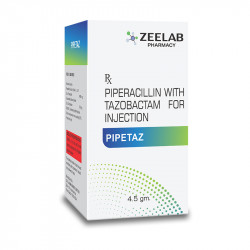Download India's most affordable pharmacy app
- Compare with medicine prices
- Save upto 90% on your medicine bills
COMPOSITION:
Piperacillin (4000mg) + Tazobactum (500mg)DESCRIPTION:
Pisa 4000 mg/500 mg Injection is a combination antibiotic used for treating various serious bacterial infections. It contains Piperacillin (4000mg), a broad-spectrum penicillin antibiotic, and Tazobactum (500mg), a beta-lactamase inhibitor. This powerful combination is effective against a wide range of bacteria that cause infections in the lungs, urinary tract, skin, abdomen, and blood. Pisa Injection is typically administered in hospitals under medical supervision and is ideal for managing moderate to severe infections quickly and effectively.
Uses of Pisa 4000 mg/500 mg Injection
Pisa Injection is prescribed for the treatment of the following infections:
- Lower respiratory tract infections (e.g., pneumonia)
- Urinary tract infections
- Intra-abdominal infections
- Skin and soft tissue infections
- Gynecological infections
- Sepsis and bloodstream infections
How Pisa 4000 mg/500 mg Injection Works
Piperacillin kills bacteria by preventing them from forming cell walls, which are essential for their survival. Tazobactum blocks bacterial enzymes that break down antibiotics, thereby enhancing the effectiveness of Piperacillin. Together, they fight even resistant bacterial strains efficiently.
Benefits of Pisa 4000 mg/500 mg Injection
- Broad-spectrum action against various bacterial infections
- Combines two powerful agents for improved effectiveness
- Fast-acting and effective in serious infections
- Reduces the duration and severity of infection
- Prevents complications associated with untreated infections
How to Take Pisa 4000 mg/500 mg Injection
Pisa Injection is administered by a doctor or nurse via intravenous (IV) infusion. The exact dose and frequency depend on the severity of the infection, patient’s age, weight, and kidney function. It is usually given every 6 to 8 hours. Do not self-administer. Always complete the full course as prescribed by your doctor, even if you feel better early.
Side Effects of Pisa 4000 mg/500 mg Injection
Common side effects:
- Nausea or vomiting
- Diarrhea
- Skin rashes or irritation
- Injection site redness or pain
Severe side effects (rare):
- Severe allergic reaction (swelling, trouble breathing)
- Severe diarrhea with blood or mucus
- Liver function changes
- Seizures in patients with kidney issues or high doses
Contact your doctor immediately if you experience any severe symptoms.
Safety Advice
- Inform your doctor if you are allergic to penicillin or similar antibiotics.
- Use cautiously if you have kidney or liver disorders.
- Tell your doctor about all current medications to avoid drug interactions.
- Not recommended during pregnancy or breastfeeding unless advised by a doctor.
- Always complete the prescribed course to avoid reinfection or resistance.
Frequently Asked Questions (FAQs)
Q: What is Pisa 4000 mg/500 mg Injection used for?
A: Pisa Injection is used to treat serious bacterial infections such as pneumonia, UTIs, intra-abdominal infections, skin infections, and sepsis.
Q: How is Pisa Injection administered?
A: It is given as an intravenous (IV) infusion by a healthcare professional in a hospital or clinic setting.
Q: Can Pisa Injection cause any side effects?
A: Yes, common side effects include nausea, diarrhea, and rash. Severe side effects are rare but require immediate medical attention.
Q: Is Pisa safe during pregnancy?
A: It should only be used during pregnancy if prescribed by a doctor after evaluating the benefits and risks.
Q: What should I do if I miss a dose?
A: Since it is given in a clinical setting, missed doses are unlikely. Inform your healthcare provider if you think a dose has been missed.








 Added!
Added!